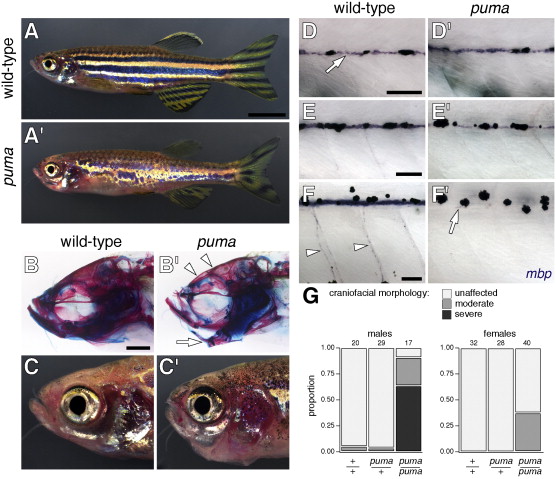Fig. 1 puma mutant adult zebrafish exhibit defects in pigment pattern, craniofacial morphology, Schwann cell development, and locomotor behavior. (A, A′) Adult stripes and craniofacial morphology are disrupted in puma mutants. (B, B′) Clearing and staining to reveal bone (red) and cartilage (blue) shows thinner dysmorphic bones of the skull in puma mutants (arrowheads) and ventral displacement of the jaw (arrow). (C, C′) External anatomy of head for wild-type and a severely affected puma mutant. (D–F) Development of Schwann cell defects. (D, D′) Early larvae exhibit mbp+ Schwann cells covering the lateral line nerve (arrow) in both wild-type and puma mutants (here, 4.0 mm standardized standard length, 4.0 SSL). (E, E′) During later post-embryonic development, mbp+ cells are more sparsely arranged in puma mutants (here, 6.3 SSL). (F, F′) mbp+ cells are nearly absent in puma mutants, with only rare residual cells found along the lateral line (arrow in F′); mbp+ cells found along dorsoventrally oriented nerves in wild-type (arrowheads in F) are completely lacking in puma (8.0 SSL). (G) Quantitative analysis of craniofacial defects in puma mutants. Shown are the proportions of individuals placed into different categories for severity of craniofacial defect, divided by sex and genotype. Numbers of individuals examined are given above the bars. Contingency table analysis shows that homozygous puma mutants were more likely than wild-type to exhibit craniofacial defects and such defects were more prevalent among males than females (genotype: X2 = 93.0, P < 0.0001; sex: X2 = 43.7, P < 0.0001; n = 171). Scale bars: in A, 4 mm for A, A′. In B, 1 mm for B, B′ in D, 60 μm for D, D′ in E, 60 μm for E, E′ in F, 60 μm for F, F′.
Reprinted from Developmental Biology, 346(2), Larson, T.A., Gordon, T.N., Lau, H.E., and Parichy, D.M., Defective adult oligodendrocyte and Schwann cell development, pigment pattern, and craniofacial morphology in puma mutant zebrafish having an alpha tubulin mutation, 296-309, Copyright (2010) with permission from Elsevier. Full text @ Dev. Biol.

